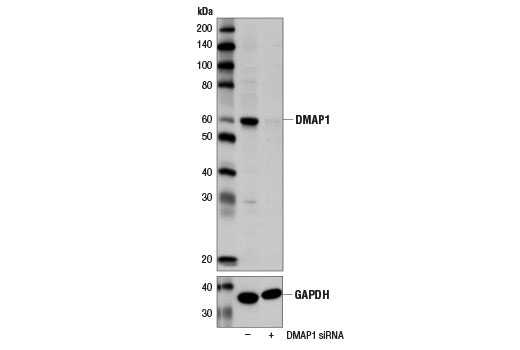#Q9NPF5
55929
Product Information
Product Usage Information
CST recommends transfection with 100 nM SignalSilence® DMAP1 siRNA I 48 to 72 hours prior to cell lysis. For transfection procedure, follow protocol provided by the transfection reagent manufacturer. Please feel free to contact CST with any questions on use.
Each vial contains the equivalent of 100 transfections, which corresponds to a final siRNA concentration of 100 nM per transfection in a 24-well plate with a total volume of 300 μl per well.
Storage
Specificity / Sensitivity
Species Reactivity:
Human
Product Description
Background
DNA methyltransferase 1 (DNMT1)-associated protein 1 (DMAP1) is a nuclear protein that functions in transcriptional repression and DNA repair. DMAP1 was first identified as an activator of DNMT1 methyltransferase activity (1). Both DMAP1 and DNMT1 are targeted to replication foci during S phase and function to transfer proper methylation patterns to newly synthesized DNA during replication (1). In late S phase, DMAP1-DNMT1 co-operate with a p33ING1-Sin3-HDAC2 complex to maintain pericentric heterochromatin by deacetylating histones, methylating histone H3 at Lys9, and methylating DNA (1,2). The DMAP1 protein is also part of the TIP60-p400 complex, a histone acetyltransferases (HAT) and chromatin-remodeling complex that functions in DNA repair (3,4). Upon DNA damage, the TIP60-p400 complex acetylates histone H4 at Lys16 to induce chromatin relaxation and activation of the ATM kinase. DMAP1 is required for DNA-damage induced TIP60-p400-mediated histone acetylation, and deletion of DMAP1 impairs AMT function (5). DMAP1-DNMT1 may also methylate DNA at sites of DNA damage during homologous recombination, which results in gene silencing (6).
- Rountree, M.R. et al. (2000) Nat Genet 25, 269-77.
- Xin, H. et al. (2004) J Biol Chem 279, 9539-46.
- Cai, Y. et al. (2003) J Biol Chem 278, 42733-6.
- Doyon, Y. et al. (2004) Mol Cell Biol 24, 1884-96.
- Penicud, K. and Behrens, A. (2013) Oncogene , 525-31.
- Lee, G.E. et al. (2010) J Biol Chem 285, 37630-40.
Species Reactivity
Species reactivity is determined by testing in at least one approved application (e.g., western blot).
Cross-Reactivity Key
H: human M: mouse R: rat Hm: hamster Mk: monkey Vir: virus Mi: mink C: chicken Dm: D. melanogaster X: Xenopus Z: zebrafish B: bovine Dg: dog Pg: pig Sc: S. cerevisiae Ce: C. elegans Hr: horse GP: Guinea Pig Rab: rabbit All: all species expected
Trademarks and Patents
使用に関する制限
法的な権限を与えられたCSTの担当者が署名した書面によって別途明示的に合意された場合を除き、 CST、その関連会社または代理店が提供する製品には以下の条件が適用されます。お客様が定める条件でここに定められた条件に含まれるものを超えるもの、 または、ここに定められた条件と異なるものは、法的な権限を与えられたCSTの担当者が別途書面にて受諾した場合を除き、拒絶され、 いかなる効力も効果も有しません。
研究専用 (For Research Use Only) またはこれに類似する表示がされた製品は、 いかなる目的についても FDA または外国もしくは国内のその他の規制機関により承認、認可または許可を受けていません。 お客様は製品を診断もしくは治療目的で使用してはならず、また、製品に表示された内容に違反する方法で使用してはなりません。 CST が販売または使用許諾する製品は、エンドユーザーであるお客様に対し、使途を研究および開発のみに限定して提供されるものです。 診断、予防もしくは治療目的で製品を使用することまたは製品を再販売 (単独であるか他の製品等の一部であるかを問いません) もしくはその他の商業的利用の目的で購入することについては、CST から別途許諾を得る必要があります。 お客様は以下の事項を遵守しなければなりません。(a) CST の製品 (単独であるか他の資材と一緒であるかを問いません) を販売、使用許諾、貸与、寄付もしくはその他の態様で第三者に譲渡したり使用させたりしてはなりません。また、商用の製品を製造するために CST の製品を使用してはなりません。(b) 複製、改変、リバースエンジニアリング、逆コンパイル、 分解または他の方法により製品の構造または技術を解明しようとしてはなりません。また、 CST の製品またはサービスと競合する製品またはサービスを開発する目的で CST の製品を使用してはなりません。(c) CST の製品の商標、商号、ロゴ、特許または著作権に関する通知または表示を除去したり改変したりしてはなりません。(d) CST の製品をCST 製品販売条件(CST’s Product Terms of Sale) および該当する書面のみに従って使用しなければなりません。(e) CST の製品に関連してお客様が使用する第三者の製品またはサービスに関する使用許諾条件、 サービス提供条件またはこれに類する合意事項を遵守しなければなりません。
